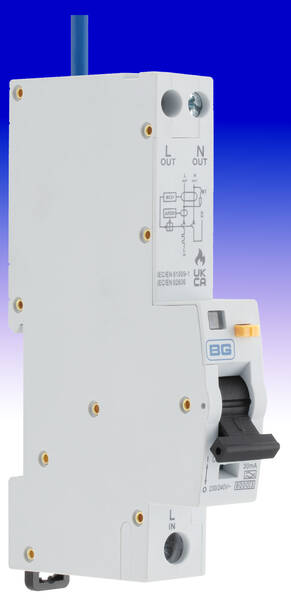40A 30mA DP AFDD/RCBO C Curve (Type A) 6KA (1 Module) (delivery 2/3 days)
Product Code: BG AFDC40A
5050765219419
CURAFDC40A-01
BG
40A 30mA C Curve Type A AFDD/RCBO
40A 30mA C Curve Type A AFDD/RCBO
AFDD + RCBO combined:
AFDDs will all have automatic test, RCCB included + test button, includes overcurrent
and fault current protection.
What causes an ARC Fault?
Pierced or damage insulation i.e., drill in the wall piercing the cable or damaging the insulation of the cable.
Trapped or crushed cables and loose cables / faulty plugs and sockets. Used on AC single phase socket circuits not exceeding 32A
How does a AFDD Work?
Hardware and firmware used within Arc Fault detection
devices programs will follow the same basic process.
1 Voltage and current signal acquisition program
2 Arc fault detection program
The main program predominantly evaluates whether the number of given arcs in a given time meets conditions to trigger the corresponding alarm and protection program.
When the number of arc events exceeds the set number of arc events required an alarm & activation tripping sequence is triggered.
The arc fault program uses the wave form “0” crossing cycle as an interrupt service to sample and save the wave form regularly.
It is this interrupt cycle that can distinguish an arc caused by plugging in and withdrawing plugs from sockets.
When the set time has passed it will discard this type of arc signal as too infrequent to be a fault.
What buildings will be compulsory.: final socket circuits not exceeding 32A
Higher Risk Residential Buildings (HRRB): over 18M high or 6 stories what ever comes 1st
Houses in Multiple Occupation (HMO)
Purpose built student accommodation
Care homes
For all other installs Recommended: AMD2 new guidance on wording: Recommended means Should.
AFDDs will all have automatic test, RCCB included + test button, includes overcurrent
and fault current protection.
What causes an ARC Fault?
Pierced or damage insulation i.e., drill in the wall piercing the cable or damaging the insulation of the cable.
Trapped or crushed cables and loose cables / faulty plugs and sockets. Used on AC single phase socket circuits not exceeding 32A
How does a AFDD Work?
Hardware and firmware used within Arc Fault detection
devices programs will follow the same basic process.
1 Voltage and current signal acquisition program
2 Arc fault detection program
The main program predominantly evaluates whether the number of given arcs in a given time meets conditions to trigger the corresponding alarm and protection program.
When the number of arc events exceeds the set number of arc events required an alarm & activation tripping sequence is triggered.
The arc fault program uses the wave form “0” crossing cycle as an interrupt service to sample and save the wave form regularly.
It is this interrupt cycle that can distinguish an arc caused by plugging in and withdrawing plugs from sockets.
When the set time has passed it will discard this type of arc signal as too infrequent to be a fault.
What buildings will be compulsory.: final socket circuits not exceeding 32A
Higher Risk Residential Buildings (HRRB): over 18M high or 6 stories what ever comes 1st
Houses in Multiple Occupation (HMO)
Purpose built student accommodation
Care homes
For all other installs Recommended: AMD2 new guidance on wording: Recommended means Should.
|
Product Code
Description
|
Price (ex VAT)
Price (inc VAT)
Quantity
|
|---|---|



